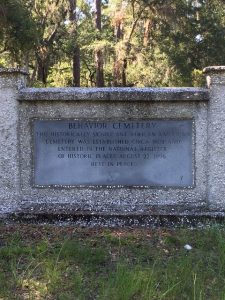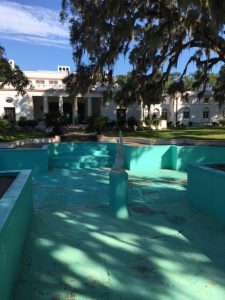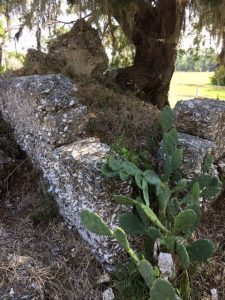 As a part of a troupe of teachers studying Reconstruction, perhaps the most misremembered time in America’s past, I headed to Sapelo Island off the Georgia coast. There a secluded community still lives today, descendants of the former enslaved peoples of the lowcountry south where sea-island cotton was grown for export to textile mills in places like New York, Manchester, and Liverpool. Our group had the chance to get to know the place ourselves. We enjoyed eating the Low Country Boil, a meal consisting of shrimp, potatoes, sausage, and corn in a broth, which locals had enjoyed for centuries. We swam in the warm waters and looked up at the starry night sky while thunder rolled in the distance. I quickly appreciated the natural beauty of the place, and why those who had toiled and bled in the fields would want their children and their children’s children to construct a new life there. Like the “mixed race people” of Malaga in the north, the Gullah-Geechee culture that lives on Sapelo today were likely maligned over the past century and a half as somehow inferior, incapable of caring for the land properly.
As a part of a troupe of teachers studying Reconstruction, perhaps the most misremembered time in America’s past, I headed to Sapelo Island off the Georgia coast. There a secluded community still lives today, descendants of the former enslaved peoples of the lowcountry south where sea-island cotton was grown for export to textile mills in places like New York, Manchester, and Liverpool. Our group had the chance to get to know the place ourselves. We enjoyed eating the Low Country Boil, a meal consisting of shrimp, potatoes, sausage, and corn in a broth, which locals had enjoyed for centuries. We swam in the warm waters and looked up at the starry night sky while thunder rolled in the distance. I quickly appreciated the natural beauty of the place, and why those who had toiled and bled in the fields would want their children and their children’s children to construct a new life there. Like the “mixed race people” of Malaga in the north, the Gullah-Geechee culture that lives on Sapelo today were likely maligned over the past century and a half as somehow inferior, incapable of caring for the land properly.
The first full day on the island, our hosts took us to see the different sites to tell the story of the people of Sapelo stretching back across the centuries. It became clear early on that this was a story fraught with deep wounds, some on the surface for all to see and others hidden just below the shallows. We saw the plantation mansion that was constructed in the early twentieth century, learned about the tabby ruins of the old chocolate plantation (not named for what was grown there), and were regaled with jokes from our bus driver who grew up on the island and returned after college to help tell these stories. One of our last stops was the Behavior cemetery, the naming of which sparked conflicting tales. Our guide explained that the first people who were buried in Behavior lived in that part of the island away from the plantation as a privilege for their “good behavior.” Of course, historical memory and folklore do not always coincide. This rather inhospitable part of the swampy island was probably not a place were enslaved people were sent on “good behaviour.” Nevertheless, the descendants of Sapelo are still buried there today. It is a sacred ground for those descended from the first African men and women brought to these shores against their wills. The names, the land, and the people convey the story of slavery and its aftermath to the current generation. As our guides explained to us, their hope was to tell this story to teachers who could explain what really happened on Sapelo, and how the promises and conflicts over emancipation are still being lived out around them.

In a noteworthy study entitled Making Gullah, historian Melissa Cooper traces the complicated narrative of early twentieth century anthropologists who became obsessed with finding the connections between black Americans and their African cultural roots. A descendant of the Gullah folk of Sapelo herself, she reveals how for decades folklore and scholarship intertwined to convey the Gullah islanders’ mystique as a distinctive cultural relic leftover from the various African cultures brought to that coast in chains. Americans in the twentieth century looked to the island as a place where the almost pagan “other” subsisted off these “isolated” swampy lands. As the people of Sapelo and the other Low Country sea islands continued to lose their land, we focused instead on the strangeness of the culture to contemporary definitions of American life and modernity. Scholars failed to reconnect the story of land acquisition to the era of Reconstruction when the promise of 40 acres to every freedman was rescinded, and the age of Jim Crow, when racial segregation was a policy in communities across the United States. Instead, the Gullah became a cultural anachronism, living as a separate creole ethnic community from other black enclaves in the Deep South.

Rather than examining our own tendencies to turn these cultural “others” into scapegoats or at best a cultural sideshow, and how the weight of the history of slavery and Jim Crow has shaped the lives of the Sapelo Islanders, for decades scholarship and popular culture focused on their linguistic connections to Africa and their supposed voodoo practices. As late as the 1990s, viewers of the children’s television show, Gullah Gullah Island, received a seemingly benign caricature of the happy island life. When we look at archetypal depictions of the happy islander dating to the first artistic renderings of the Taino people from Columbus’ voyages, we must also consider the historical tendency for these stereotypical images to serve as justification for paternalism. Education about Gullah-Geechee culture becomes all the more vital when one considers that this process of historical erasure has continued into the latter half of the twentieth and the early twenty-first century, with the simultaneous appropriation of Gullah into popular culture and the “acquisition” of land from Gullah-Geechee communities on Hilton Head and St. Simons Island, both of which have become popular vacation destinations since the 1950s.
Us mainlanders are drawn to the “mystique” that surrounds any group of people who are “deliberately” isolated. We ask ourselves, “how did this group last all the way out here for so long?” We answer: “history is inevitable, it will catch up to them someday.” Maybe we should revisit the example of Malaga once again. Not to say the United States government or the government of Georgia for that matter will forcibly evict Sapelo and incarcerate its population, but what about other methods of forced eviction? Instead of asking how Gullah culture has been able to last as long as it has in some sort of defiance of a contrived ideal of cultural “sameness,” perhaps our inquiry should focus on how increasing taxes on coastal property are crowding Gullah people out of their homes and continuing the seemingly inescapable American trend of Manifest Destiny. According to one NYTimes article, property taxes for some of the inhabitants of Sapelo increased nearly 540% over 2011-12 alone. Today, the people of Hog Hammock on Sapelo occupy a sliver of the land enslavers forced their ancestors to cultivate. There is more we can learn about what these coastal communities reveal about our own imaginations, and the exotic images and implicit judgements we attach to them. Perhaps what is even more salient to the mission of this blog, is our need to remember that land, history, and memory often intertwine, and that the gentle ebb and flow of the Atlantic waves cannot erase the past.
Further Reading
Bailey, Cornelia, and Christena Bledsoe. God, Dr. Buzzard, and the Bolito Man: A Saltwater Geechee Talks About Life On Sapelo Island. New York: Anchor Books, a Division of Random House, 2001.
Bruchac, Margaret. “Revisiting Pocumtuck History in Deerfield: George Sheldon’s Vanishing Indian Act,” Historical Journal of Massachussetts, Vol. 39 (1&2), Summer 2011. 32-77.
Cooper, Melissa L. Making Gullah: A History of Sapelo Islanders, Race, and the American Imagination. The John Hope Franklin Series in African American History and Culture. Chapel Hill: The University of North Carolina Press, 2017.
Day, Holman. “The Queer Folk of the Maine Coast.” Harper’s Monthly Magazine. September, 1909. 521-30. http://www.unz.org/Pub/Harpers-1909sep-00521
Wylie, Alison. “Making Alternative Histories: Epistemic Disunity and Political Integrity,” in Making Alternative Histories: The Practice of Archaeology and History in Non-Western Settings, ed. Peter R. Schmidt and Thomas C. Patterson. Santa Fe, NM: School of American Research Press. 1995. 255-72.
